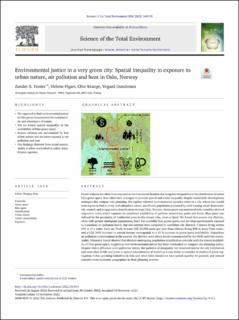| dc.contributor.author | Venter, Zander | |
| dc.contributor.author | Figari, Helene | |
| dc.contributor.author | Krange, Olve | |
| dc.contributor.author | Gundersen, Vegard | |
| dc.coverage.spatial | Oslo, Norway | en_US |
| dc.date.accessioned | 2023-02-28T11:13:10Z | |
| dc.date.available | 2023-02-28T11:13:10Z | |
| dc.date.created | 2023-02-13T14:19:03Z | |
| dc.date.issued | 2022 | |
| dc.identifier.issn | 0048-9697 | |
| dc.identifier.uri | https://hdl.handle.net/11250/3054576 | |
| dc.description.abstract | Poorer citizens are often more exposed to environmental hazards due to spatial inequalities in the distribution of urban blue-green space. Few cities have managed to prevent spatial and social inequality despite sustainable development strategies like compact city planning. We explore whether environmental injustice exists in a city where one would least expect to find it: a city with abundant nature, an affluent population governed by a left leaning social democratic city council, and an aggressive densification strategy; Oslo, Norway. Green space was measured with a satellite-derived vegetation index which captures the combined availability of gardens, street trees, parks and forest. Blue space was defined by the proximity of residential areas to the closest lake, river or fjord. We found that poorer city districts, often with greater immigrant populations, have less available blue-green spaces and are disproportionately exposed to hazardous air pollution levels, but not extreme heat compared to wealthier city districts. Citizens living within 100 m of a water body are likely to earn US$ 20,000 more per year than citizens living 500 m away from water, and a US$ 3000 increase in annual income corresponds to a 10 % increase in green space availability. Hazardous air pollution concentrations in the poorest city districts were above levels recommended by the WHO and Oslo municipality. Historical trends showed that districts undergoing population densification coincide with the lowest availability of blue-green space, suggesting that environmental justice has been overlooked in compact city planning policy. Despite Oslo's affluence and egalitarian ideals, the patterns of inequality we observed mirror the city's historical east-west class divide and point to spatial concentration of wealth as a core factor to consider in studies of green segregation. Urban greening initiatives in Oslo and other cities should not take spatial equality for granted, and instead consider socio-economic geographies in their planning process. Green space Blue space Densification Urban nature Urban sustainability Exposure | en_US |
| dc.language.iso | eng | en_US |
| dc.rights | Navngivelse 4.0 Internasjonal | * |
| dc.rights.uri | http://creativecommons.org/licenses/by/4.0/deed.no | * |
| dc.subject | Green space | en_US |
| dc.subject | Blue space | en_US |
| dc.subject | Densification | en_US |
| dc.subject | Urban nature | en_US |
| dc.subject | Urban sustainability | en_US |
| dc.subject | Exposure | en_US |
| dc.title | Environmental justice in a very green city: Spatial inequality in exposure to urban nature, air pollution and heat in Oslo, Norway | en_US |
| dc.title.alternative | Environmental justice in a very green city: Spatial inequality in exposure to urban nature, air pollution and heat in Oslo, Norway | en_US |
| dc.type | Peer reviewed | en_US |
| dc.type | Journal article | en_US |
| dc.description.version | publishedVersion | en_US |
| dc.rights.holder | © 2022 The Authors | en_US |
| dc.subject.nsi | VDP::Samfunnsgeografi: 290 | en_US |
| dc.subject.nsi | VDP::Human geography: 290 | en_US |
| dc.source.volume | 858 | en_US |
| dc.source.journal | Science of the Total Environment | en_US |
| dc.identifier.doi | 10.1016/j.scitotenv.2022.160193 | |
| dc.identifier.cristin | 2125670 | |
| dc.relation.project | Norges forskningsråd: 160022 | en_US |
| cristin.ispublished | true | |
| cristin.fulltext | original | |
| cristin.qualitycode | 2 | |

